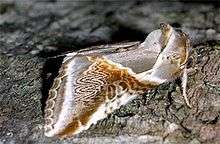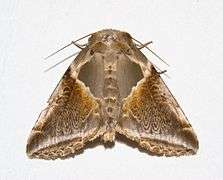Buff arches
The buff arches (Habrosyne pyritoides) is a moth of the family Drepanidae. The species was first described by Johann Siegfried Hufnagel in 1766. It is found throughout Europe and is well distributed in the British Isles except the far north of England and all of Scotland.
| Buff arches | |
|---|---|
 | |
| Scientific classification | |
| Kingdom: | |
| Phylum: | |
| Class: | |
| Order: | |
| Family: | |
| Genus: | |
| Species: | H. pyritoides |
| Binomial name | |
| Habrosyne pyritoides (Hufnagel, 1766) | |
| Synonyms | |
| |
This is a distinctive and attractive species; its grey-brown forewings are marked with bold buff-orange "arches". The hindwings are grey with white margins. The wingspan is 40–45 mm. It flies from June to August and is attracted to light and sugar.
The larva is orange brown with a prominent white spot on each side of the head and feeds on bramble, hawthorn and hazel. The species overwinters as a pupa.
- ^ The flight season refers to the British Isles. This may vary in other parts of the range.

 Both sides
Both sides
Subspecies
- Habrosyne pyritoides pyritoides (Europe, northern Iran)
- Habrosyne pyritoides derasoides (Butler, 1878) (south-eastern Russia, Korean Peninsula, Japan, China: Heilongjiang, Jilin, Liaoning, Beijing, Hebei)
References
- Chinery, Michael Collins Guide to the Insects of Britain and Western Europe 1986 (Reprinted 1991)
- Skinner, Bernard The Colour Identification Guide to Moths of the British Isles 1984
External links
| Wikimedia Commons has media related to Habrosyne pyritoides. |
| Wikispecies has information related to Habrosyne pyritoides |
- Kimber, Ian. "65.009 BF1653 Buff Arches Habrosyne pyritoides (Hufnagel, 1766)". UKMoths. Retrieved 29 June 2019.
- Lepiforum e.V.
This article is issued from Wikipedia. The text is licensed under Creative Commons - Attribution - Sharealike. Additional terms may apply for the media files.